|
|
|
Sort Order |
|
|
|
Items / Page
|
|
|
|
|
|
|
| Srl | Item |
| 1 |
ID:
090989
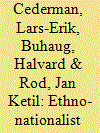

|
|
|
|
|
| Publication |
2009.
|
| Summary/Abstract |
Previous quantitative research on ethnic civil war relies on macro-level proxies in an attempt to specify the conditions under which ethnic minorities rebel. Going beyond an exclusive focus on minorities, the present study employs Geographic Information Systems (GIS) as a way to model ethnic center-periphery dyads that confront governments with excluded groups. We construct and analyze a new dataset of geo-referenced politically relevant ethnic groups, covering the entire world during the period from 1951 through 2005. Our results show that the conflict probability of marginalized groups increases with the demographic power balance compared to the group(s) in power. Furthermore, the risk of conflict increases with the distance from the group to the capital, and the roughness of the terrain in the group's settlement area. We also find that while the results for demographic group strength hold for all ethnic civil wars, the geographic factors apply for territorial ethnic conflicts only.
Previous quantitative research on ethnic civil war relies on macro-level proxies in an attempt to specify the conditions under which ethnic minorities rebel. Going beyond an exclusive focus on minorities, the present study employs Geographic Informat
|
|
|
|
|
|
|
|
|
|
|
|
|
|
|
|
| 2 |
ID:
090993


|
|
|
|
|
| Publication |
2009.
|
| Summary/Abstract |
Why do some armed civil conflicts last longer than others? Drawing on a contest success function model, we show that geographic factors (such as location, terrain, and natural resources) interact with rebel fighting capacity and together play a crucial role in determining the duration of conflict. Using precisely dated duration data in event history models and geographic data for the conflict location, we find that conflicts located at considerable distance from the main government stronghold, along remote international borders and in regions with valuable minerals last substantially longer. In addition, we find that rebel military capacity in its own right increases the prospects of a civil conflict ending within a short time period. Our findings imply that the distances an army must travel to project power, rebel fighting capacity, and characteristics of conflict region affect how a civil war is fought and who will prevail.
|
|
|
|
|
|
|
|
|
|
|
|
|
|
|
|
| 3 |
ID:
090998
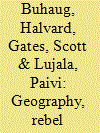

|
|
|
|
|
| Publication |
2009.
|
| Summary/Abstract |
Why do some armed civil conflicts last longer than others? Drawing on a contest success function model, we show that geographic factors (such as location, terrain, and natural resources) interact with rebel fighting capacity and together play a crucial role in determining the duration of conflict. Using precisely dated duration data in event history models and geographic data for the conflict location, we find that conflicts located at considerable distance from the main government stronghold, along remote international borders and in regions with valuable minerals last substantially longer. In addition, we find that rebel military capacity in its own right increases the prospects of a civil conflict ending within a short time period. Our findings imply that the distances an army must travel to project power, rebel fighting capacity, and characteristics of conflict region affect how a civil war is fought and who will prevail
|
|
|
|
|
|
|
|
|
|
|
|
|
|
|
|
| 4 |
ID:
090987
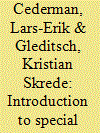

|
|
|
|
|
| Publication |
2009.
|
| Summary/Abstract |
We introduce the contributions to this special issue on "Disaggregating Civil War." We review the problems arising from excessive aggregation in studies of civil war, and outline how disaggregation promises to provide better insights into the causes and dynamics of civil wars, using the articles in this special issue as examples. We comment on the issue of the appropriate level of disaggregation, lessons learned from these articles, and issues for further research.
We introduce the contributions to this special issue on "Disaggregating Civil War." We review the problems arising from excessive aggregation in studies of civil war, and outline how disaggregation promises to provide better insights into the causes
|
|
|
|
|
|
|
|
|
|
|
|
|
|
|
|
| 5 |
ID:
091000
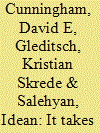

|
|
|
|
|
| Publication |
2009.
|
| Summary/Abstract |
Theories of conflict emphasize dyadic interaction, yet existing empirical studies of civil war focus largely on state attributes and pay little attention to nonstate antagonists. We recast civil war in a dyadic perspective, and consider how nonstate actor attributes and their relationship to the state influence conflict dynamics. We argue that strong rebels, who pose a military challenge to the government, are likely to lead to short wars and concessions. Conflicts where rebels seem weak can become prolonged if rebels can operate in the periphery so as to defy a government victory yet are not strong enough to extract concessions. Conflicts should be shorter when potential insurgents can rely on alternative political means to violence. We examine these hypotheses in a dyadic analysis of civil war duration and outcomes, using new data on nonstate actors and conflict attributes, finding support for many of our conjectures.
|
|
|
|
|
|
|
|
|
|
|
|
|
|
|
|
| 6 |
ID:
091067
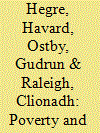

|
|
|
|
|
| Publication |
2009.
|
| Summary/Abstract |
This article examines the link between subnational poverty and the location of civil war events. Drawing on the ACLED dataset, which breaks internal conflicts down to individual events at the local level, we take a disaggregated approach to the study of conflict. Local-level socioeconomic data are taken from the Liberian Demographic and Health Survey. With geographical cells of approximately 76 km 2 as units of analysis, we test how absolute and relative welfare affect the presence and number of conflict events during the 1989-2002 Liberian civil war. We control for neighboring conflict events, distance to Monrovia and national borders, population density, diamond deposits, and ethnic affiliations. War events were more frequent in the richer locations. This may provide better support for "opportunity" explanations than for "relative deprivation" theories of conflict, but we argue that the relative weakness of the Liberian government makes it difficult to distinguish between the two.
|
|
|
|
|
|
|
|
|
|
|
|
|
|
|
|
| 7 |
ID:
091069


|
|
|
|
|
| Publication |
2009.
|
| Summary/Abstract |
In this article we propose a new typology for insurgent groups to explain why in such remarkably similar conflicts-Sri Lanka and Aceh-the impact of the 2004 Indian Ocean Tsunami was so different. We argue that two principal factors shape all rebel groups by defining their incentive structures: the efficiency of the return on investment of the primary source(s) of support and the group's territorial objectives. The former factor is especially strong in explaining the different choices made by the LTTE and GAM. In Sri Lanka, the availability of lucrative resources outside the country has made the LTTE leadership inimical to compromise, threatened by relief aid, and less reliant on the local population. Lacking access to such high-return funding sources, GAM on the other hand was more closely linked to the needs of the local population and found greater value in both outside aid and a comprehensive settlement.
|
|
|
|
|
|
|
|
|
|
|
|
|
|
|
|
|
|
|
|
|